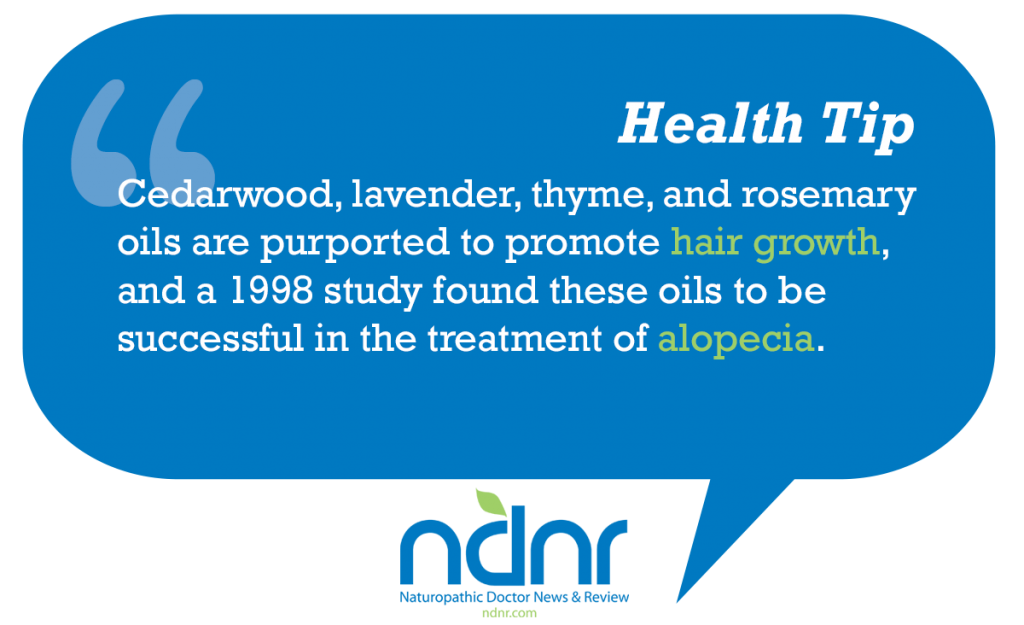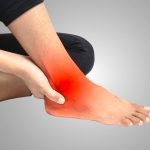Treating Female Pattern Hair Loss
Stacey Shillington, nd
Female pattern hair loss (FPHL) is a common condition characterized by a diffuse reduction in hair density over the crown and frontal scalp with retention of the frontal hairline.1 As many as 10% of premenopausal women reportedly have some evidence of FPHL; however, the incidence increases greatly in menopausal women.2 As many as 50% to 75% of women 65 years or older may be affected by FPHL.2 The psychological implications of FPHL are profound; there is a significant association between perceptions of hair loss and rates of depression in women.3
What Causes FPHL?
Unlike male pattern hair loss, which is clearly linked to increased androgen activity, the cause of FPHL is not as clear-cut. In some cases, hyperandrogenism is connected with FPHL, but in many instances there is no evidence of increased androgenic activity.4
Women with FPHL due to hyperandrogenism often exhibit other signs of increased androgens such as hirsutism, acne, and menstrual disturbances. If these symptoms exist, elevated serum androgens are not always necessary to attribute the FPHL to hyperandrogenism.5 In women, most androgens are produced in either the adrenals or the ovary. In cases where FPHL is observed but androgens are not elevated, the official cause is uncertain.
Regardless of whether the FPHL is androgen dependent or not, the follicular changes are the same; the anagen phase of the hair growth cycle appears to be shortened,5 and follicular miniaturization occurs, which results in smaller and finer hairs being produced with each hair cycle. This causes the hair to become finer as time progresses and can eventually result in scarring alopecia, where the hair follicle stops producing hair altogether.
Evaluating FPHL
Female pattern hair loss may mimic other conditions, and a proper evaluation should be done to rule out telogen effluvium, alopecia areata, and early cicatricial alopecia. The most common condition that can mimic FPHL is telogen effluvium, which is characterized by thinning or shedding of hair, resulting from the early entry of hairs into the telogen phase.6 This pattern can be the result of emotional or physiological stress such as eating disorders, fever, childbirth, chronic illness, surgery anemia, emotional disorders, crash diets, hypothyroidism, and drugs.7 Telogen effluvium is nonscarring or reversible, and it does not result in the miniaturization of hair follicles. A full naturopathic workup includes the following tests, ranging from complete hormone panel to heavy metals.
Complete Hormone Panel
To evaluate FPHL, a complete hormone panel is necessary, including free testosterone, dehydroepiandrosterone (DHEA), the ratio of luteinizing hormone (LH) to follicle-stimulating hormone (FSH), progesterone, estradiol, estrone, cortisol, and dihydrotestosterone (DHT). Often, there will be elevated levels of free testosterone or DHEA, or the LH/FSH ratio will be elevated. This LH/FSH ratio is normally 1:1, but if it is elevated to 2:1 to 3:1, a diagnosis of polycystic ovary syndrome (PCOS) may be considered.8 Androgens are converted to estrogens via the aromatase enzyme, so elevated levels of estrone and estradiol may also indicate excess androgenic activity. Low levels of progesterone can also contribute to FPHL. Testosterone converts to DHT with the aid of the type 2 enzyme class 5alpha-reductase, which is found in the hair follicles. Dihydrotestosterone is the main perpetrator of androgenic hair loss,9 and its levels can be high due to the overactivity of 5alpha-reductase, despite normal testosterone levels.10 It must be noted that, although DHT is a proven contributor to male pattern hair loss, its involvement in FPHL is not as well understood.
Complete Blood Cell Count, Total Iron-Binding Capability, Iron, and Ferritin
Iron deficiency is associated with hair loss.11 Hair follicles contain ferritin, and reduced stores of ferritin in the follicle can lead to the production of vellus (nonpigmented fine hair), which can mimic the hair miniaturization observed in FPHL.12
Thyrotropin, Free Triiodothyronine, and Free Thyroxine
Hair follicles are direct targets of the thyroid hormones triiodothyronine (T3) and thyroxine (T4), which modulate hair biology parameters from cycling to pigmentation. Specifically, T4 encourages hair growth, and a combination of T3 and T4 downregulates programmed cell death.13
Vitamins and Trace Minerals
Many nutrient deficiencies have been linked with hair loss. Levels of vitamins and trace minerals should be tested, including zinc, copper, red blood cell magnesium, manganese, vitamin B12, folic acid, vitamin D (25-hydroxyvitamin D), and vitamin C. See the Appendix Table for more information.
Heavy Metals
One study14 suggests that certain people with alopecia may have higher lead, cadmium, and copper levels, which can potentially displace zinc and contribute to alopecia. If heavy metals are detected, a heavy metal detox must be implemented so the body can rebalance itself.
Naturopathic Treatments for FPHL
Treating hair loss is not easy, and the results of treatment are often not observed for months. Patience is required for both the practitioner and the patient. However, fortifying the general health of the patient, including diet therapy, insulin regulation, adrenal health, and hormonal regulation, will provide a strong foundation for success.
Optimal Nutrition, Vitamins, and Minerals
As Hippocrates famously advised thousands of years ago, “Let food be thy medicine.” As with any naturopathic treatment, proper nourishment is required to firmly establish health and resolve illness. Treating any type of hair loss, including FPHL, is no exception. Proper gut health and food absorption should be established, and the diet should consist of lean organic protein, vegetables, fruits, nuts, and seeds. Refined, simple carbohydrates should be avoided completely to prevent insulin reactivity, and adequate protein must be incorporated into the diet. Ensure that all the nutrients outlined in the Appendix Table are evaluated and corrected if necessary. A standard protocol of zinc, biotin, manganese, and silica supplementation may be helpful in FPHL.
Balance Insulin Levels
Research has shown that high insulin levels have been linked to both female and male pattern hair loss,15 and significant positive associations have been observed between FPHL and metabolic syndrome.16,17 In addition to diet therapy, there are a variety of herbs and nutraceuticals that can be used to treat insulin resistance and metabolic syndrome. Inositol, which helps to establish healthy cell membranes and has a role in fat metabolism, has been shown to reduce the symptoms of insulin resistance and increased androgen levels,18 both hallmarks of PCOS. Gymnema sylvestre is another naturopathic remedy that can be used to manage insulin resistance and metabolic syndrome; the gymnemic acids in the plant curb the binding of carbohydrates to the receptors in the intestine, limiting glucose absorption and reducing the insulin response.19 In addition to inositol and Gymnema, recent research has suggested that the plant-based compounds rho-iso-alpha acids from Humulus lupulus (hops) and proanthocyanidins from Acacia nilotica have been shown to modulate insulin signaling.20 This formulation has been particularly useful in my clinical practice.
Strengthen the Adrenals
Managing the effects of stress is a necessity in any successful naturopathic treatment, and hair loss is no exception. In fact, stress is directly related to alopecia areata, telogen effluvium, and trichotillomania.21 In the case of FPHL, stress can trigger increased production of the androgen DHEA,22 which is produced exclusively in the adrenal glands. Stress reduction and stress management are critical, and the selection of adaptogens must be done carefully as many adaptogens can actually increase androgens. Adaptogenic herbs that tend to be antiandrogenic include Foeniculum vulgare, Urtica dioica, Ocimum sanctum, and Trigonella foenum-graecum.23 Even in cases of FPHL where androgens are not elevated, a stress management and adrenal strengthening program is indicated as reducing stress can only improve the body’s ability to strengthen itself and function optimally.
Balance Androgen Levels
If androgens are elevated, a protocol to reduce the androgens must be implemented. In addition to using the aforementioned antiandrogenic adaptogens, Serenoa repens is an herb with a long history of reducing androgens through its DHT-blocking action.24,25 Other herbs that have been shown to lower DHT activity include Pygeum africanum and Urtica dioica,23 and herbs that inhibit 5alpha-reductase activity include Camellia sinensis and Panax ginseng.26 Although the efficacy of antiandrogenic herbs has been studied mainly on male patients, many clinicians routinely prescribe these herbs for the symptoms of PCOS and FPHL.
Balance Progesterone Levels
In addition to evaluating and treating high androgen levels, it is imperative that estrogen and progesterone levels are examined. Estrogen dominance, which is a very common condition, can arise due to environmental estrogens, decreased nutrition, use of oral birth control pills, and anovulatory periods. This situation results in elevated levels of estrogen and decreased levels of progesterone. Not only is progesterone an antagonist to DHT, the testosterone metabolite that wreaks havoc with hair follicles, but also the body responds to low levels of progesterone by increasing its production of the adrenal cortical steroid androstenedione. This steroid is an alternative precursor for the production of other adrenal cortical hormones, and it conveys some androgenic activity. When progesterone levels are raised by progesterone supplements, the androstenedione level will gradually fall, and normal hair growth will eventually resume. Since hair growth is a slow process, it may take 4 to 6 months for the effects to become apparent.27 The best-known herb to increase progesterone levels is Vitex agnus-castus,28 although its action of increasing LH levels may antagonize some symptoms of PCOS. Alternatively, bioidentical progesterone cream can be used to successfully increase progesterone levels.
Topical Treatments
Topical solutions should not be overlooked when treating FPHL as the hair follicles are easily accessible with topical medications. Although topical applications may not completely resolve the problem, they can offer an effective temporary solution, while long-term permanent solutions are being implemented. In fact, currently the only Food and Drug Administration–approved treatment for FPHL is topical minoxidil, 2%.5 Furthermore, a 2004 study29 reported that the topical application of melatonin, 1%, solution for 6 months in women with androgenic or diffuse hair loss resulted in a significantly increased anagen hair rate, resulting in reduced hair loss.
Essential oils have been anecdotally used to treat alopecia of all kinds for over 100 years. Cedarwood, lavender, thyme, and rosemary oils are purported to have hair growth–promoting properties, and a 1998 study30 found these oils to be successful in the treatment of alopecia areata.
Using emu oil as a carrier for the aforementioned essential oils may be an excellent therapeutic option for FPHL. A study31 published by Dr Michael Horlick of Boston University School of Medicine (Boston, Massachusetts) in the January 1996 issue of Drug & Cosmetic Industry claims that topical application of emu oil shifted 80% of hair follicles from resting to anagen phase. Emu oil contains oleic acid, which gives it the ability to penetrate deeply into the scalp. It is also anti-inflammatory and functions as a 5alpha-reductase inhibitor.
Mesotherapy is a technique that can also be beneficial for FPHL. Shallow injections deliver vitamins, minerals, and botanicals directly to the hair follicles, providing nutrition and antiandrogenic action. Although there are no studies confirming its efficacy, mesotherapy is a common treatment for FPHL in Europe and South America.
Daily hair washing may also be used to treat FPHL as it can help to eliminate excess sebum from the hair follicle.32 Sebum can contribute to clogging, congestion, and impairment of the hair follicle function.
In Conclusion
The naturopathic treatment of FPHL is not always easy. However, it is imperative that we continue to research and share our experiences with this condition as there are many women who need our help.
 Stacey Shillington, ND graduated from the Canadian College of Naturopathic Medicine (Toronto, Ontario, Canada) in 2006. She has since established a practice in downtown Toronto focusing on naturopathic antiaging and skin care, including mesotherapy and cosmetic acupuncture. For more information, visit her website at www.naturopathicbeauty.com, or follow her on Twitter @dr_shillington.
Stacey Shillington, ND graduated from the Canadian College of Naturopathic Medicine (Toronto, Ontario, Canada) in 2006. She has since established a practice in downtown Toronto focusing on naturopathic antiaging and skin care, including mesotherapy and cosmetic acupuncture. For more information, visit her website at www.naturopathicbeauty.com, or follow her on Twitter @dr_shillington.
References
- Olsen EA. Female pattern hair loss. J Am Acad Dermatol. 2001;45:570-580.
- Norwood OT. Incidence of female androgenetic alopecia (female pattern alopecia). Dermatol Surg. 2001;27(1):53-54.
- Schmitt JV, Ribeiro CF, Souza FH, Siqueira EB, Bebber FR. Hair loss perception and symptoms of depression in female outpatients attending a general dermatology clinic. An Bras Dermatol. 2012;87(3):412-417.
- Futterweit MD, Dunaif A, Yeh HC, Kingsley P. The prevalence of hyperandrogenism in 109 consecutive female patients with diffuse alopecia. J Am Acad Dermatol. 1988;19:831-836.
- Olsen EA, Messenger AG, Shapiro J, et al. Evaluation and treatment of male and female pattern hair loss. J Am Acad Dermatol. 2005;52(2):301-311.
- Marks JG, Miller J. Lookingbill and Marks’ Principles of Dermatology. 4th ed. New York, NY: Elsevier Inc; 2006:263.
- Freedberg IM, Eisen AZ, Wolff K, Austen KF, Goldsmith LA, Katz S, eds. Fitzpatrick’s Dermatology in General Medicine. 6th ed. New York, NY: McGraw-Hill; 2003.
- Lab Tests Online. PCOS. http://labtestsonline.org/understanding/conditions/pcos/start/2. Accessed October 15, 2012.
- Andersson S, Berman DM, Jenkins EP, Russell DW. Deletion of steroid 5alpha-reductase 2 gene in male pseudohermaphroditism. Nature. 1991;354:159-161.
- Larson M. Hair loss & low testosterone. http://www.livestrong.com/article/302151-hair-loss-low-testosterone. Accessed October 15, 2012.
- Moeinvaziri M, Mansoori P, Holakooee K, Safaee Naraghi Z, Abbasi A. Iron status in diffuse telogen hair loss among women. Acta Dermatovenerol Croat. 2009;17(4):279-284.
- HairSite.com. Iron deficiency & women’s hair loss. http://www.hairsite2.com/library/article194.htm. Accessed October 15, 2012.
- van Beek N, Bodó E, Kromminga A, et al. Thyroid hormones directly alter human hair follicle functions: anagen prolongation and stimulation of both hair matrix keratinocyte proliferation and hair pigmentation. J Clin Endocrinol Metab. 2008;93:4381-4388.
- Naginiene R, Abdrachmanovas O, Kregzdyte R, Ryselis S. Investigation of heavy metals in people with alopecia. Trace Elements Electrolytes. 2002;19(2):87-90.
- Signorello LB, Wuu J, Hsieh C, Tzonou A, Trichopoulos D, Mantzoros CS. Hormones and hair patterning in men: a role for insulin-like growth factor 1. J Am Acad Dermatol. 1999;40:200-203.
- Yi SM, Son SW, Lee KG, et al. Gender-specific association of androgenetic alopecia with metabolic syndrome in middle-aged Korean population. Br J Dermatol. 2012;167(2):306-313.
- Matilainen V, Laakso M, Hirsso P, Koskela P, Rajala U, Keinänen-Kiukaanniemi S. Hair loss, insulin resistance, and heredity in middle-aged women: a population-based study. J Cardiovasc Risk. 2003;10(3):227-231.
- Iuorno MJ, Jakubowicz DJ, Baillargeon JP, et al. Effects of D-chiro-inositol in lean women with the polycystic ovary syndrome. Endocr Pract. 2002;8(6):417-423.
- Kanetkar P, Singhal R, Kamat M. Gymnema sylvestre: a memoir. J Clin Biochem Nutr. 2007;41(2):77-81.
- Minich DM, Lerman RH, Darland G, et al. Hop and Acacia phytochemicals decreased lipotoxicity in 3T3-L1 adipocytes, db/db mice, and individuals with metabolic syndrome [published online May 18, 2010]. J Nutr Metab. doi:10.1155/2010/467316. Medline:20721358
- Mayo Clinic: Stress management: can stress cause hair loss? http://www.mayoclinic.com/health/stress-and-hair-loss/AN01442. Accessed October 15, 2012.
- Gambineri A, Vicennati V, Genghini S, et al. Genetic variation in 11beta-hydroxysteroid dehydrogenase type 1 predicts adrenal hyperandrogenism among lean women with polycystic ovary syndrome. J Clin Endocrinol Metab. 2006;91(6):2295-2302.
- Your hormones. Testo-Quench. http://www.yourhormones.com/testo-quench/index.html. Accessed October 15, 2012.
- Marks LS, Hess DL, Dorey FJ, Luz Macairan M, Cruz Santos PB, Tyler VE. Tissue effects of saw palmetto and finasteride: use of biopsy cores for in situ quantification of prostatic androgens. Urology. 2001;57(5):999-1005.
- Chizick S, inventor. Natural preparation for treatment of male pattern hair loss. US patent 5,972,345. October 26, 1999. http://www.google.com/patents/US5972345. Accessed October 15, 2012.
- Kaushik R, Gupta D, Yadav R. Alopecia: herbal remedies. Int J Pharm Sci Res. 2011;2(7):1631-1637.
- Lee JR. What Your Doctor May Not Tell You About Menopause. New York, NY: Warner Books Inc; 1996:323.
- Milewicz A, Gejdel E, Sworen H, et al. Vitex agnus castus extract in the treatment of luteal phase defects due to latent hyperprolactinemia: results of a randomized placebo-controlled double-blind study [in German]. Arzneimittelforschung. 1993;43(7):752-756.
- Fischer TW, Burmeister G, Schmidt HW, Elser P. Melatonin increases anagen hair rate in women with androgenic alopecia or diffuse alopecia: results of a pilot randomized controlled trail. Br J Dermatol. 2004;150(2):341-345.
- Hay I, Jamieson M, Ormerod A. Randomized trial of aromatherapy: successful treatment for alopecia areata. Arch Dermatol. 1998;134(11):1349-1352.
- MPB Research. Emu oil hairloss and frontal regrowth. http://www.hairloss-research.org/EmuOilfrontalregrowth.html. Accessed October 15, 2012.
- Yáñez Soler AJ. Cultural evolution as a possible triggering or causative factor of common baldness. Med Hypotheses. 2004;62(6):980-985.










